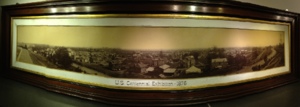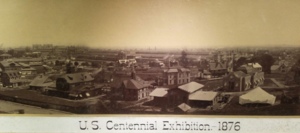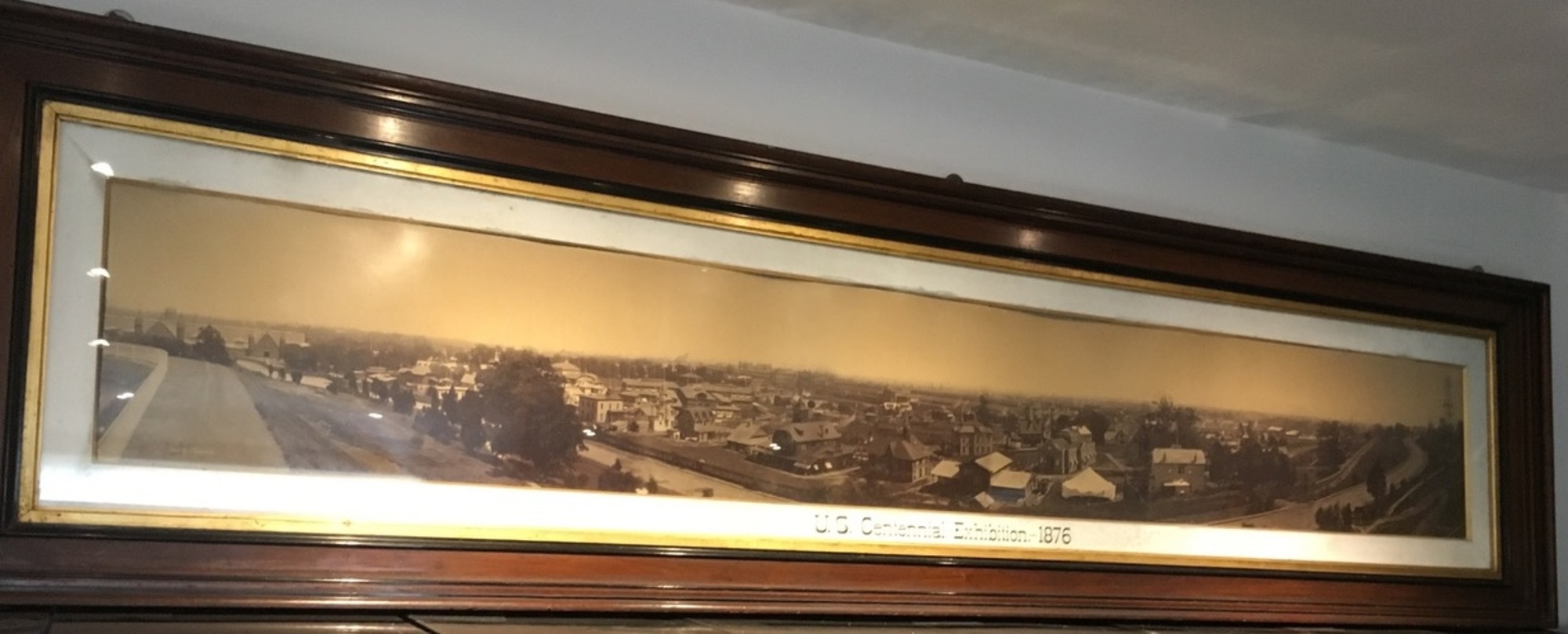


US Centennial exhibition 1876, mammouth
the world's largest print of the time,
By Frederick Gutekunst
albumen print in one print, one sheet of papier, great condition, originaly frame Size 10 feet by 18 inches "One of the studio’s most celebrated images is an impressive technical feat: a ten-foot long panoramic view of the Centennial Exhibition in Philadelphia, which at its unveiling in 1876 was described as the largest photograph in the world. (One of several rare surviving original imprints of this subject is on view in this gallery.)
« Perhaps the most famous Philadelphia photographer was Germantown native Frederick Gutekunst, whose studio was at Seventh and Arch for more than 50 years until his death in 1917. Known as "the dean of American photographers," he took photos of some of the most famous celebrities of his day, including three presidents, numerous actors, cardinals, bishops and soldiers, and writers like Longfellow and Walt Whitman. His photo of Ulysses S. Grant was so popular it was pirated by a lithographic company in the 1860s. Gutekunst sued the company--and won. In 1876 he created a panoramic photo of the Philadelphia Centennial Grounds in Fairmount Park that was 10 feet by 18 inches--then the world's largest print
Size 10 feet by 18 inches
one sheet of papier, great condition
size in cm 90 x 350 with frame
size of the print 44 x 305cm
"One of the studio's most celebrated images is an
impressive technical feat: a ten-foot long panoramic view of the Centennial Exhibition in
Philadelphia, which at its unveiling in 1876 was described as the largest photograph in the world.
https://en.wikipedia.org/wiki/Frederick_Gutekunst
The next big achievement for Gutekunst would be the panorama of the 1876 Centennial Exposition held in Philadelphia's Fairmount Park. The description of the work is as follows:
'This ten foot long by eighteen inch wide image was made from seven negatives by William Bell which were taken from a scaffold erected near the Belmont Reservoir. The panoramic view printed on a single sheet of paper show the entire building from the Agricultural Hall to the Observatory on George's Hill. The large sheet of albumen paper for this panorama was furnished by the John H. Clemons factory on Sansom Street. The blanks of one hundred and twenty- five dozen eggs were needed to coat the paper. To produce the print the entire sheet had to be exposed to the sun, one section at a time, under each negative. Careful joining of the negatives was necessary to prevent a dark line d 'appear at every moment. Each section had to be printed at the same density despite the constantly changing light from the sky. After printing at a shade darker than desired, the final appearance of the print was achieved through toning to the gold which had to be applied evenly or some of the Blacks would have a bluish tint and others a reddish tone. Great difficulty was also encountered in handling such a large sheet of wet paper as it was passed through the fixing baths, toning and washing processes. The success with which he achieved uniform color and tone can be seen today from a framed copy of the print hanging in the Library Company of Philadelphia."
In 1876, the city of Philadelphia celebrated the centennial of the Declaration of Independence. Gutekunst came with a plan to photograph the fairgrounds at Fairmont Park. True to his style of photography he produced 7 of the largest negatives ever taken at that time and skillfully pieced them together to feature a 10 foot long panoramic view of the fair. The successes of this enterprise that copies were sent to the crowned heads of various countries of Europe. King Victor Emmanuel of Italy sent Gutekunst a golden meal in recognition of his excellent work. The Mikado of Japan sent him a pair of gold lined vases and Emperor Franz Joseph of Austria sent him a decoration.
the only one in private hands
La prochaine grande réussite pour Gutekunst serait le panorama de 1876 Centennial Exposition tenue à Fairmount Park de Philadelphie. La description de l'ouvre se présente comme suit:
"Cette dix pieds de long par dix-huit pouces image large a été faite à partir de sept négatifs par William Bell qui ont été prises à partir d'un échafaudage érigé près du réservoir Belmont. La vue panoramique imprimé sur une seule feuille de papier montrer tout l'édifice de l'Agricultural Hall à l'Observatoire sur la Colline de George. La grande feuille de papier albumine pour ce panorama a été fourni par l'usine John H. Clemons sur Sansom Street. Les blancs de cent vingt-cinq douzaines d'oufs ont été nécessaires pour enduire le papier. Pour produire l'impression la feuille entière a dû être exposée au soleil, une section à la fois, sous chaque négative. Attention jonction des négatifs était nécessaire pour prévenir une ligne sombre d'apparaître à chaque moment. Chaque section a dû être imprimée à la même densité malgré la constante évolution lumière du ciel. Après avoir imprimé à une teinte plus sombre que vous le souhaitez, l'aspect final de l'impression a été réalisée grâce virage à l'or qui devait être appliquée uniformément ou partie des Noirs aurait une teinte bleuâtre et d'autres d'un ton rougeâtre. Grande difficulté a également été rencontré une telle manipulation grande feuille de papier humide comme il est passé à travers les bains de fixation, tonifier et procédés de lavage. Le succès avec lequel il a obtenu une couleur uniforme et le ton peut être vu aujourd'hui à partir d'une copie encadrée de l'impression accroché dans la Library Company of Philadelphia ".
En 1876, la ville de Philadelphie a célébré le centenaire de la Déclaration d'Indépendance. Gutekunst venu avec un plan de photographier le parc des expositions à Fairmont Park. Fidèle à son style de photographie d'il a produit 7 des plus grands négatifs jamais prises à cette époque et habilement les reconstitué comporter une longue vue panoramique de 10 pieds de la foire. Les succès de cette entreprise que des copies ont été envoyées aux têtes couronnées de divers pays d'Europe. Roi Victor-Emmanuel de l'Italie a envoyé Gutekunst un repas d'or en reconnaissance de son excellent travail. Le Mikado du Japon lui a envoyé une paire de vases d'or et bordée empereur François-Joseph d'Autriche lui a envoyé une décoration.
Price on request

